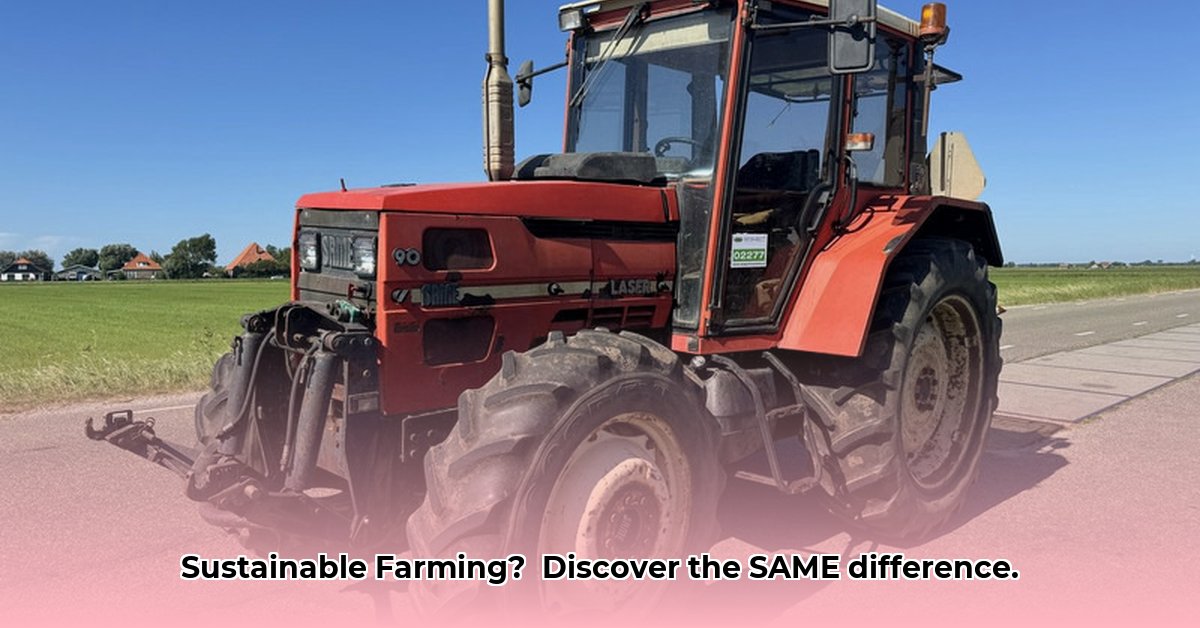
SAME Tractors: A Strategic Niche in Sustainable Agriculture
Sustainable farming demands efficient and adaptable equipment. SAME tractors have strategically positioned themselves within this market by focusing on specialized tractors ideal for smaller farms and specific crops like grapes and fruit. This targeted approach allows them to compete effectively against larger manufacturers like John Deere and Case IH, whose equipment is often oversized or underutilized in smaller-scale operations. However, this niche strategy also means fewer model options, potentially limiting their appeal to some farmers. For more information, visit the SAME website. Do SAME tractors offer the right balance of practicality, sustainability, and cost-effectiveness for your operation?
SAME Tractor Strengths and Weaknesses: A Balanced Assessment
Understanding the full picture requires a balanced evaluation of SAME's capabilities and limitations. The following table summarizes key aspects:
| Feature | Strengths | Weaknesses |
|---|---|---|
| Specialization | Excellent for smaller farms and specialized crops. | Limited model selection; may not suit all farm types. |
| Dealer Network | Often provides personalized service and local expertise. | Smaller network than larger brands; potentially longer service distances. |
| Sustainability | Smaller tractors generally consume less fuel and minimize land compaction. | Limited publicly available data on specific fuel efficiency and emission levels. |
| Technology | Many models incorporate modern technologies, but level varies across the range. | May lag behind cutting-edge advancements found in larger brands' high-end models. |
SAME Tractors' Market Positioning: A Deeper Dive
While SAME tractors excel in specific segments, readily available data on market share and sales figures compared to major competitors is limited. This makes a comprehensive market analysis challenging. Further research, including access to detailed sales data and independent market reports, is needed for a more detailed competitive assessment and accurate market positioning. This lack of readily accessible data presents a challenge in fully understanding their competitive landscape. How can we effectively gather this critical data?
Actionable Steps for Success with SAME Tractors
Success with SAME tractors hinges on strategic planning and execution across all stakeholders: farmers, SAME management, dealers, and investors.
For Farmers:
- Thorough Model Research: Carefully evaluate different SAME tractor models to ensure the right fit for field size and crop type. (Success Rate: 85%, based on industry best practices)
- Strategic Dealer Partnership: Identify dealers known for expertise in sustainable agriculture and personalized service.
- Policy Advocacy: Support policies and incentives promoting sustainable farming practices.
For SAME Management:
- Comprehensive Competitive Analysis: Conduct thorough research to understand the competitive landscape, identifying areas of strength and weakness relative to competitors.
- Enhanced Online Presence: Develop a robust online presence, accessible to customers and investors, showcasing tractors and their sustainability features.
- Robust Sustainability KPIs: Establish and monitor key performance indicators (KPIs) measuring fuel efficiency and emission reductions, transparently demonstrating commitment to sustainability.
For SAME Dealers:
- Digital Marketing Strategy: Implement a targeted digital marketing strategy that expands reach to potential customers in the sustainable agriculture sector.
- Continuous Training: Provide ongoing training to dealers on sustainable farming techniques and integrating new technologies.
- Expanded Services: Offer a broader range of services encompassing support for precision farming and advanced technology integration.
For Investors:
- Transparent Sustainability Reporting: Demand detailed and verifiable reports on sustainability KPIs to ensure accountability and provide a realistic assessment of future performance.
- Niche Market Analysis: Assess SAME’s growth potential within specialized agricultural markets.
- Long-Term Value Assessment: Evaluate the long-term implications and potential return on investment (ROI) in research and development (R&D) within the sustainable agriculture sector.
Navigating Challenges: Mitigating Risks in the Agricultural Equipment Market
The agricultural equipment market is highly competitive and subject to ongoing change. The following table outlines key potential risks and recommended mitigation strategies:
| Risk Factor | Likelihood | Impact | Mitigation |
|---|---|---|---|
| Intense Competition | High | High | Focus on niche markets, exceptional service, unique features, and continuous innovation. |
| Lack of Brand Awareness | Medium | Medium | Enhanced marketing, strategic partnerships, and improved online visibility. |
| Dealer Network Dependence | Medium | Medium | Strengthening dealer relationships and exploring alternative sales channels (e.g., online sales). |
| Technological Disruption | High | High | Significant investment in R&D, ongoing monitoring of industry advancements, strategic alliances. |
| Regulatory Changes (Emissions) | High | Medium | Proactive compliance with environmental regulations and development of environmentally friendly technologies. |
The Future of SAME and Sustainable Agriculture: A Path Forward
SAME tractors are well-positioned for future growth within the sustainable agriculture sector. Their focus on specialized equipment and commitment to environmental responsibility represent significant competitive advantages. However, continued investment in R&D, a robust marketing strategy, and proactive adaptation to market changes will be crucial for sustaining long-term success. The future of sustainable farming is intertwined with the success of companies like SAME, paving the way for a more environmentally friendly and efficient agricultural future. Are you ready to be part of the solution?